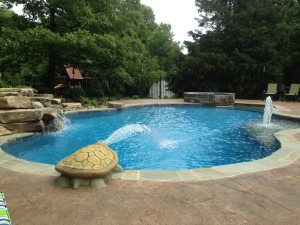 Your pool pump is a crucial component to your filtration system and most people think a higher horsepower rating will lead to greater efficiency. In fact, so many consumers thought that way that manufacturers started changing the way they rated pumps. Unfortunately, a higher horsepower does not make a better pump. Having a properly sized pump will help you avoid excess wear on your other equipment and keep you from wasting electricity. There are a few variables that play into choosing the right size pump for your pool and we’re going to go over them with you today.
Your pool pump is a crucial component to your filtration system and most people think a higher horsepower rating will lead to greater efficiency. In fact, so many consumers thought that way that manufacturers started changing the way they rated pumps. Unfortunately, a higher horsepower does not make a better pump. Having a properly sized pump will help you avoid excess wear on your other equipment and keep you from wasting electricity. There are a few variables that play into choosing the right size pump for your pool and we’re going to go over them with you today.
The first thing you want to determine is your desired turnover time, or how long it takes for the pump to cycle all of a swimming pool’s water completely. An ideal turnover time is 8 – 10 hours, so in this example we’re going to look for a pump with an 8 hour turnover time. Once we have the desired turnover time, we need to find the minimum flow rate to achieve that turnover time. The equation for finding your GPM rating (gallons per minute) is:
Pool size (gallons)/ Turnover time / 60 = Minimum flow rate
For example: if our pool is 35,000 gallons and we want a turnover rate of 8 hours, our equation would look like this: 35,000 / 8 / 60 = 73 GPM (gallons per minute)For this example we will use a 35,000 gallon pool. According to the table above, we need a pump with a 73 GPM rating in order to achieve an 8 hour turnover time. Even though we figured out how much water needs to be pumped, the water can only flow at the maximum rate if the plumbing is big enough to accommodate it. Below is a chart that shows how much water each different size pipe diameter supports:
1-1/2″ = 42 GPM, 2″ = 73 GPM, 2-1/2″ = 120 GPM, 3″ = 160 GPM
The number of intakes you have from your pool (and spa if you have one attached to the pool) also affects the maximum flow rate. For example, if we have two inlets from the pool both plumbed in 2 inch line and a spa that’s also plumbed in 2 inch line, we would have a pool max flow rate of 146 GPM and a spa flow rate of 73 GPM (since we have 2 intakes from the pool, the number is doubled). But if you have two, you want to go with the lowest number, so our maximum flow rate would be 73 GPM.As our pool water makes it through the line to the pump, it is passed to another restricting element known as the filter. Every filter has a maximum flow rate as well, and if you go over that flow rate your water will not be filtered properly. We have included a chart so you can size your pool filter properly:
| Sand Filters | |||||
| Tank Diameter | 19″ | 21″ | 24″ | 30″ | 36″ |
| Surface Area | 1.8 sq ft | 2.3 sq ft | 3.1 sq ft | 4.9 sq ft | 6.9 sq ft |
| Best Flow Rate | 40 GPM | 50 GPM | 60 GPM | 100 GPM | 140 GPM |
| Cartridge Filters | |||||
| Surface Area | 100 sq ft | 200 sq ft | 300 sq ft | 400 sq ft | 500 sq ft |
| Max flow Rate | 38 GPM | 75 GPM | 112 GPM | 150 GPM | 150 GPM |
| Best Flow Rate | 30 GPM | 50 GPM | 75 GPM | 100 GPM | 125 GPM |
| D.E. Filters | |||||
| Surface Area | 24 sq ft | 36 sq ft | 48 sq ft | 60 sq ft | 72 sq ft |
| Max Flow Rate | 48 GPM | 72 GPM | 96 GPM | 120 GPM | 144 GPM |
| Best Flow Rate | 36 GPM | 54 GPM | 72 GPM | 90 GPM | 108 GPM |
